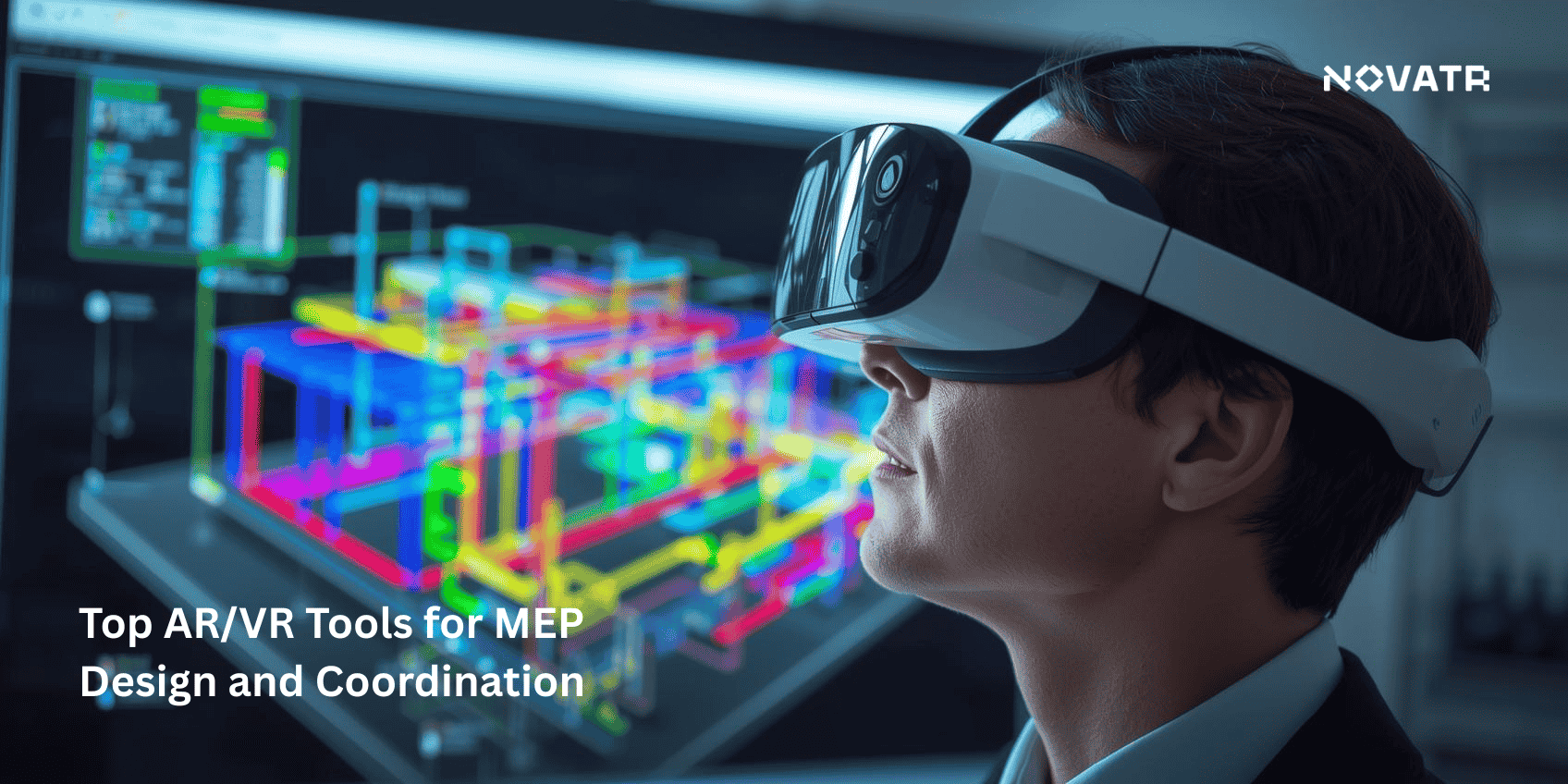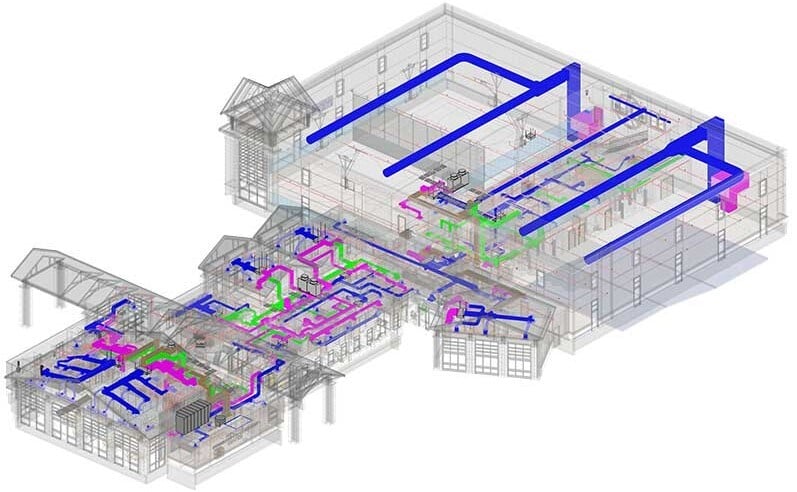
Advances in digital tools are reshaping MEP projects, allowing teams to visualize designs and identify potential issues early. Workflows have become more streamlined, and coordination across disciplines is smoother. In the USA, the average AR/VR engineer salary is $115,864/year, showing the value of this expertise in integrating technology effectively into design and project management.
Teams increasingly rely on virtual reality in MEP coordination to perform immersive project walkthroughs, ensuring designs align with practical requirements. Similarly, augmented reality for construction supports real-time overlays, helping detect conflicts and improve collaboration. These tools reduce errors, enhance communication, and provide a structured approach to complex MEP systems without adding extra workload.
How AR and VR Are Transforming MEP Design and Coordination?
Modern construction increasingly leverages immersive technologies to explore designs interactively and visualize complex system layouts before implementation. This approach helps teams anticipate challenges and evaluate multiple solutions efficiently. Additionally, AR VR applications in mechanical electrical plumbing allow detailed visualization of components, supporting precision without overloading the workflow or disrupting standard procedures.
The following key transformations highlight the impact of AR and VR in MEP coordination:
-
Streamlined collaboration between engineers, designers, and contractors, improving shared understanding of project layouts.
-
Faster identification and resolution of spatial conflicts within MEP systems.
-
Interactive walkthroughs and instant feedback demonstrate how AR VR improves MEP project collaboration across teams.
-
Enhanced planning efficiency through clear visualization of complex installations and sequencing.
Key Benefits of Using AR/VR Tools in MEP Design and Clash Detection
Understanding the impact of AR/VR in MEP workflows highlights how modern projects integrate immersive solutions for better visualization and system analysis. Teams can simulate complex layouts and examine interactions before construction, improving design clarity. These advancements rely heavily on MEP engineering principles to maintain accuracy and coordination throughout project stages.
-
Early detection of design conflicts, minimizing the risk of errors during construction.
-
Faster iterations and design adjustments by visualizing system layouts in real-time.
-
Collaborative problem-solving enabled by the use of AR VR in clash detection and coordination, reducing delays.
-
Streamlined project management with immersive representations, supported by advanced MEP software for precise planning.
Also Read: Career Opportunities for MEP Engineers in the Middle East
Top AR/VR Tools Used by MEP Professionals in 2026
Here are the top tools shaping MEP design and coordination in 2025, with immersive design visualization helping teams assess layouts and systems more effectively:
1. Enscape
Enscape is a real-time rendering plugin that integrates with CAD and BIM software. It provides immersive walkthroughs and VR previews, allowing teams to evaluate spatial layouts and system configurations effectively. The platform offers instant 3D visualization for MEP engineers without extra file exports or complex workflows.
2. Arkio
Arkio is a collaborative design platform that enables teams to model, edit, and review architectural and MEP concepts in VR. Its intuitive interface allows simultaneous multi-user input, making it ideal for early-stage planning and coordination across disciplines.
3. Autodesk Workshop X
Autodesk Workshop X provides a VR-enabled environment for immersive project review. It connects directly with BIM models, enabling real-time exploration of MEP systems, clash detection, and informed decision-making before construction begins.
4. Revizto
Revizto centralizes BIM data into a real-time, collaborative VR environment. It allows designers and engineers to view clashes, comment, and track issues, supporting more efficient project coordination and transparent communication across teams.
5. GAMMA AR
GAMMA AR overlays MEP designs onto real-world spaces using augmented reality. It helps teams visualize installations on-site, verify dimensions, and detect potential conflicts without relying solely on 2D plans.
6. Resolve
Resolve is a VR-enabled coordination tool designed for construction review. It allows immersive navigation of BIM models, highlights clashes, and provides collaborative annotation, reducing miscommunication and speeding up resolution of design issues.
7. Fuzor
Fuzor combines BIM integration with VR simulation, enabling real-time walkthroughs, clash detection, and construction sequencing. It provides visual and interactive insights into MEP layouts, assisting project managers and engineers in planning efficiently.
8. Unreal Engine
Unreal Engine delivers high-fidelity visualization of MEP systems in VR. It offers photorealistic rendering, interactive walkthroughs, and simulation of lighting, mechanical, and electrical systems for design validation and stakeholder reviews.
9. Twinmotion
Twinmotion allows real-time 3D visualization of MEP models, providing immersive walkthroughs and instant rendering. Its easy interface supports VR exploration, helping designers and clients evaluate spatial layouts and system integration effectively.
10. IrisVR
IrisVR converts BIM models into VR experiences, offering immersive walkthroughs and spatial analysis. It enables multi-user collaboration, issue tagging, and design validation, enhancing coordination across disciplines and reducing onsite errors.
Did You Know?
The AR/VR market in design and construction is projected to exceed $62.9 billion by 2029, with growing adoption across engineering and construction industries for advanced visualization and project planning.
How These Tools Improve Collaboration and Reduce Project Rework

Project teams are adopting immersive platforms to explore designs interactively and evaluate complex layouts before construction. By running real-time simulations, they achieve better coordination, clearer communication, and efficient scenario testing. With AR VR in construction, stakeholders can visualize system interactions and anticipate potential issues effectively.
-
Real-time model previews help teams detect clashes and align design decisions quickly.
-
The latest AR VR platforms for BIM-based MEP design allow multiple users to review and edit models collaboratively.
-
AR-enabled walkthroughs for MEP system design provide immersive perspectives to spot potential conflicts before implementation.
-
VR-based training tools for MEP engineers improve team proficiency and reduce errors during construction.
-
Construction technology tools centralize updates and track progress, keeping all stakeholders informed and minimizing rework.
Challenges in Adopting AR/VR Technology for MEP Coordination

Implementing AR/VR for MEP design can affect project timelines, team adaptation, and data management. Organizations must carefully plan integration and training, as using AR tools for engineering design may introduce complexity without proper workflows or experience with immersive platforms.
Key challenges in adopting AR/VR technology for MEP coordination are:
-
High initial costs of AR/VR hardware and software can be a barrier for smaller firms.
-
Integration with existing BIM systems may be complex, requiring additional technical expertise.
-
Teams may face a learning curve when adapting to immersive tools, slowing early adoption.
-
Limited standardization in AR/VR workflows can create inconsistencies in model interpretation and collaboration.
Also Read: Boost Your MEP Engineering Career with BIM Mastery
Conclusion
Immersive technologies are transforming MEP project workflows, allowing teams to explore layouts interactively and simulate various scenarios. BIM integration with AR/VR ensures accurate coordination across models and helps maintain consistency throughout complex designs.
The BIM Course for MEP Engineers offered by Novatr guides engineers in applying immersive solutions effectively. Using virtual reality tools for construction coordination, teams can evaluate systems clearly, track updates, and enhance collaboration.
Visit our resource page to access practical insights and support for implementing these technologies in real-world MEP projects.
FAQs
1. How do AR/VR tools improve design coordination in MEP workflows?
AR/VR tools allow teams to visualize and interact with MEP systems in 3D, detect clashes early, and coordinate designs more efficiently across disciplines.
2. Can AR/VR tools directly integrate with BIM models like Revit or Navisworks?
Yes, many AR/VR platforms connect directly with BIM models, enabling real-time updates, immersive walkthroughs, and synchronized collaboration with Revit or Navisworks data.
3. What are the benefits of using AR vs VR in MEP projects?
AR overlays designs on real environments for on-site verification, while VR provides fully immersive simulations for design review, clash detection, and project planning.
Was this content helpful to you



.jpg)



